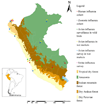Department of Defense influenza and other respiratory disease surveillance during the 2009 pandemic
- PMID: 21388566
- PMCID: PMC3092416
- DOI: 10.1186/1471-2458-11-S2-S6
Department of Defense influenza and other respiratory disease surveillance during the 2009 pandemic
Abstract
The Armed Forces Health Surveillance Center's Division of Global Emerging Infections Surveillance and Response System (AFHSC-GEIS) supports and oversees surveillance for emerging infectious diseases, including respiratory diseases, of importance to the U.S. Department of Defense (DoD). AFHSC-GEIS accomplishes this mission by providing funding and oversight to a global network of partners for respiratory disease surveillance. This report details the system's surveillance activities during 2009, with a focus on efforts in responding to the novel H1N1 Influenza A (A/H1N1) pandemic and contributions to global public health. Active surveillance networks established by AFHSC-GEIS partners resulted in the initial detection of novel A/H1N1 influenza in the U.S. and several other countries, and viruses isolated from these activities were used as seed strains for the 2009 pandemic influenza vaccine. Partners also provided diagnostic laboratory training and capacity building to host nations to assist with the novel A/H1N1 pandemic global response, adapted a Food and Drug Administration-approved assay for use on a ruggedized polymerase chain reaction platform for diagnosing novel A/H1N1 in remote settings, and provided estimates of seasonal vaccine effectiveness against novel A/H1N1 illness. Regular reporting of the system's worldwide surveillance findings to the global public health community enabled leaders to make informed decisions on disease mitigation measures and controls for the 2009 A/H1N1 influenza pandemic. AFHSC-GEIS's support of a global network contributes to DoD's force health protection, while supporting global public health.
Figures
References
-
- Clinton WJ. Presidential Decision Directive NSTC-7. The White House; 1996.
-
- Gray GC. Acute respiratory disease in the military. Federal Practioner. 1995;12:27–33.
-
- Pazzaglia G, Pasternack M. Recent trends of pneumonia morbidity in U.S. Naval personnel. Mil Med. 1983;148(8):647–651. - PubMed
Publication types
MeSH terms
LinkOut - more resources
Full Text Sources
Medical



